Quadratics appear all the time in algebra, and we know that x2 is positive (or zero) for every real x. However, this still leaves the question of whether a quadratic function can return negative values.
So, can a quadratic be negative? A quadratic can be negative (that is, have negative outputs or y values) for some or all of the x values in its domain. A quadratic can have one, two, or three negative coefficients. The zeros of a quadratic can also be negative.
Of course, there are some quadratics that are never negative. For example, the quadratic f(x) = x2 + 1 has a minimum value of 1 on its domain (all real numbers).
In this article, we’ll talk about when a quadratic is negative and how it can happen. We’ll also look at some examples, and we’ll answer some other common questions about quadratics as well.
Let’s get started.
Can A Quadratic Be Negative?
A quadratic can be negative for some or all of the x values in its domain. This will depend on the coefficients, but a quadratic with three negative coefficients is not necessarily always negative.
Remember that a quadratic function has the form:
- f(x) = ax2 + bx + c
where a, b, and c are real numbers and a is nonzero.
There are 3 basic cases for a quadratic and its y values (outputs):
- Always Negative – the y values of these quadratics are always negative (and possibly zero). From a graphical perspective, the equation gives us a parabola that is always below (or on) the x axis. The coefficient of x2 must be negative (that is, a < 0), but this alone does not guarantee that the quadratic will always be negative.
- Sometimes Negative – these quadratics have some negative y values, some positive y values, and some zero y values. From a graphical perspective, the equation gives us a parabola that intersects the x-axis (sometimes it is below the x-axis, sometimes it is above the x-axis, and sometimes it is on the x-axis).
- Never Negative – the y values of these quadratics are never negative (they are always positive and possibly zero). From a graphical perspective, the equation gives us a parabola that is always above the x axis. The coefficient of x2 must be positive (that is, a > 0), but this alone does not guarantee that the quadratic will always be positive.
Let’s look at an example of each one of these cases.
A Quadratic That Is Always Negative (Always Below The X-axis)
Consider the quadratic function f(x) = -x2 – 1.
This function will always be negative. The reasoning is as follows:
- x2 >= 0 [for real x values]
- x2 + 1 >= 1 [add 1 to both sides of the equation above]
- -(x2 + 1) <= -1 [multiply both sides by -1, which means we must reverse the inequality symbol]
- -x2 – 1 <= -1 [distribute the -1 through parentheses]
- f(x) <= -1 [definition of f(x)]
Since f(x) is always less than or equal to 1, then the y-values of this quadratic are always negative.
So, this quadratic is always negative (below the x-axis).
You can see the graph of this function below.
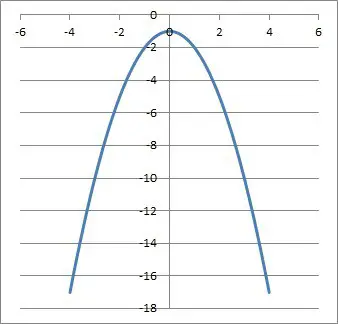
A Quadratic That Is Sometimes Negative (Both Below & Above The X-axis)
Consider the quadratic function f(x) = x2 – 1.
This function will sometimes be negative, sometimes positive, and sometimes zero. The reasoning is as follows:
f(2) = 22 – 1 = 4 – 1 = 3 > 0
f(1) = 12 – 1 = 1 – 1 = 0
f(0) = 02– 1 = 0 – 1 = -1 < 0
Since we can find three different x values to give us a positive, negative, and zero y values, this means that the function f(x) is sometimes negative, sometimes positive, and sometimes zero.
You can see the graph of this function below.

A Quadratic That Is Never Negative (Always Above The X-axis)
Consider the quadratic function f(x) = x2 + 1.
This function will always be positive. The reasoning is as follows:
- x2 >= 0 [for real x values]
- x2 + 1 >= 1 [add 1 to both sides of the equation above]
- f(x) >= 1 [definition of f(x)]
Since f(x) is always greater than or equal to 1, then the y-values of this quadratic are always positive.
So, this quadratic is always positive (above the x-axis) and never negative.
You can see the graph of this function below.
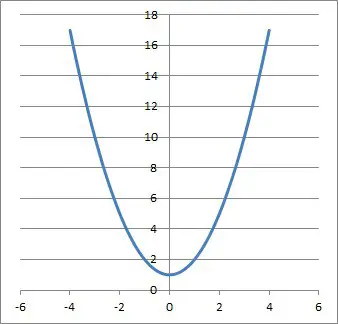
Can A Quadratic Function Be A Straight Line?
A quadratic function cannot be a straight line. It will always have the shape of a parabola when graphed.
The reason comes from the definition of a quadratic function:
f(x) = ax2 + bx + c
where a, b, and c are real numbers and a is nonzero.
The key is the last part: a is nonzero. If a = 0, then we would no longer have a quadratic function, but rather a linear function f(x) = bx + c.
Can A Quadratic Function Be Periodic?
A quadratic function cannot be periodic. A periodic function repeats y values at regular intervals, but a quadratic does not do this.
You can see the graph of a periodic function (sinusoidal) pictured in the graph below.

This function repeats the same y values infinitely many times over the range of the function (all real numbers).
However, a quadratic can repeat a y value at most once. We can see this in the graph below by imagining any horizontal line, which intersects the function at most twice:
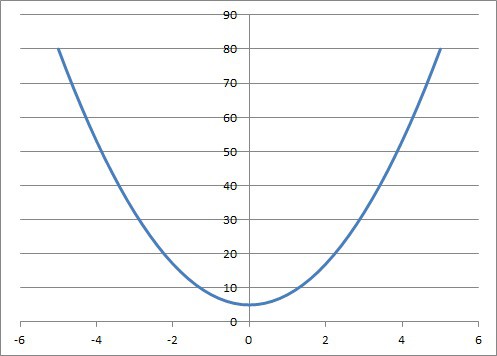
The reason is that for any y-value we can imagine (call it D), there are at most two possible real solutions to the equation f(x) = D or ax2 + bx + c = D.
You can also learn more about what the solutions of a quadratic equation represent in my article here.
Can A Quadratic Function Have 3 Zeros?
A quadratic function cannot have 3 zeros. A quadratic function can have at most 2 real zeros.
The cases for the solutions (zeros) of a quadratic are as follows:
- Two Real Roots – this happens when the discriminant b2 – 4ac > 0 (that is, when the expression under the radical in the quadratic formula is positive).
- One Real Root – this happens when the discriminant b2 – 4ac = 0.
- No Real Roots – this happens when the discriminant b2 – 4ac < 0.
We can also see this from the graph of a quadratic: a horizontal line will intersect a parabola at most two times. So, the horizontal line y = 0 can only intersect a parabola twice, not three times.
Remember that the zeros (roots) of a quadratic can also be negative in some cases.
For example:
- f(x) = x2 + 3x + 2 factors as (x + 1)(x + 2), which has two negative zeros: x = -1 and x = -2.
- f(x) = x2 + 2x + 1 factors as (x + 1)(x + 1), which has one negative zeros: x = -1 (a real repeated root).
- f(x) = x2 – 3x + 2 factors as (x – 1)(x – 2), which has two positive zeros: x = 1 and x = 2 (no negative zeros).
Can A Quadratic Function Open Sideways?
A quadratic that opens sideways, such as x = y2, is not a function, since it fails the vertical line test.

We can see this easily with the points (1, -1) and (1, 1), which are both on the graph of x = y2. They both lie on the vertical line x = 1.
This means the vertical line x = 1 intersects the parabola x = y2 twice. So, this relation fails the vertical line test.
(You can get a refresher on the difference between functions and relations in my article here).
Can A Quadratic Function Have An Inverse?
A quadratic function cannot have an inverse if it is defined over the set of real numbers.
A function must be one-to-one to have an inverse. However, a quadratic is not one-to-one on its domain of the entire set of real numbers (that is, every quadratic function fails the horizontal line test).
However, we can restrict the domain of a quadratic function to make it one-to-one. In that case, it would have an inverse on the restricted domain.
To do this, we would need to restrict the quadratic function’s domain to x >= v, where v is the vertex of the parabola. Remember that the x-coordinate of the vertex of a parabola is v = -b/2a.
We would also need to restrict the domain so that we only take positive square roots.
So, for the quadratic function f(x) = 3x2 + 24x + 48, we would need to restrict the domain to x >= v, where v = -b / 2a = -(24) / 2(3) = -24 / 6 = -4.
So, f(x) = 3x2 + 24x + 48 has an inverse if the domain is restricted to x >= -4.
To find its inverse, we let f(x) = y and solve for x:
- y = 3x2 + 24x + 48
- y = 3(x2 + 8x + 16) [factor out a GCF of 3 on the right side]
- y = 3(x + 4)2 [factor the perfect square trinomial]
- y / 3 = (x + 4)2 [divide by 3 on both sides]
- (y / 3)1/2 = x + 4 [take the square root of both sides]
- (y / 3)1/2 – 4 = x [subtract 4 from both sides]
Thus, the inverse is f-1(x) = (x / 3)1/2 – 4 (valid for x >= 0).
Can A Quadratic Function Have A Local Maximum?
A quadratic function can have a local maximum, which is in fact its global or absolute maximum.
Any quadratic function with a negative x2 coefficient (that is, a < 0) will have a local maximum at its vertex.
We can see this from the graph of a parabola with a < 0:
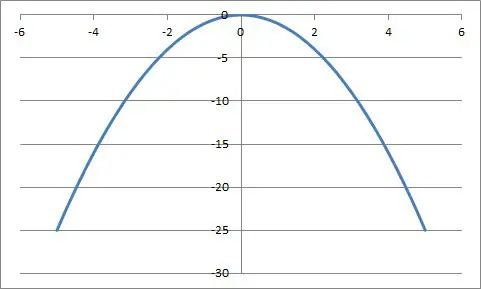
We can also see this with calculus by taking derivatives.
If f(x) = ax2 + bx + c, then:
- The first derivative is f’(x) = 2ax + b, which is zero at x = -b / 2a (that is, the vertex is a critical point of the function).
- The second derivative is f’’(x) = 2a, which is always negative for a < 0. This means the function is always concave down, and the vertex is the highest point, or a local maximum.
On the other hand, a parabola with a > 0 will always have a local minimum (which is also a global or absolute minimum) at the vertex.
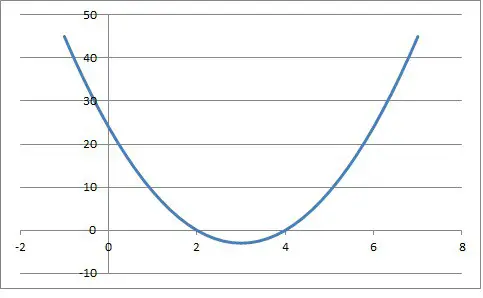
Conclusion
Now you know when a quadratic can be negative and how it can happen. You also know the answers to some other common questions about quadratic functions.
You can learn about how to solve and graph quadratic inequalities in my article here.
You might also want to check out my article on how to change the shape of a parabola.
I hope you found this article helpful. If so, please share it with someone who can use the information.
Don’t forget to subscribe to my YouTube channel & get updates on new math videos!
~Jonathon

